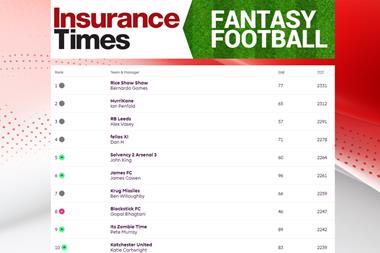Bad US home loans have spawned a labyrinth of business losses, leaving insurers facing a potential bill of $3bn. James Dean explains
It is difficult to imagine how a problem that started with poor American homeowners could eventually cause the first run on a UK bank for a century. And, increasingly, it is becoming difficult for some financial executives, and indeed anyone who has come close to sub-prime debt, to accept that they have to take a slice of the blame for the resulting crisis.
The problems they face are shared by the insurers which write their directors’ and officers’ (D&O) and errors and omissions (E&O) policies.
Two recent reports, from Willis and Guy Carpenter, predict that insurance losses will be nearer to analysts’ upper estimates of $3bn (£1.46bn) – or, according to Guy Carpenter, 30% to 35% of D&O premium.
Analysts have already estimated that the crisis could cost the London market alone as much as $500m (£244m). Over the past few months Novae and Ace have been notified of potential claims. It is almost certain that other insurers have received similar notifications and are waiting with bated breath for the conclusion of litigations in the US.
This litigation is expected to run well into 2008, and Guy Carpenter estimates the “final answer” on the crisis will not come until 2008 or 2009. Until then, the rot continues to spread, even to those who might have previously felt safe.
Boardrooms in every financial district will contain some worried men in suits, sweating on the possibility that they could be held liable for negligent investment choices. Their shareholders are not happy.
“One reason why the impact is likely to be greater than appears is that investors may begin to file against companies not involved in sub-prime lending,” says the Guy Carpenter report. “Investors are still filing, new causes of action continue to be discovered, and the list of potentially affected companies is likely to keep growing.”
The Willis report voices similar concerns. “The impact is not limited to financial services firms, with industries as diverse as automotive, manufacturing, food services, media and energy all suffering consequences.
“In these industries, the credit crisis has either delayed or cancelled bond offerings, spin-offs and acquisitions, or simply made these transactions more costly than originally planned.”
Liability chain
This is a key point: although there may be discomfort in bankers’ boardrooms, the chain of liability is becoming longer, linking in other businesses and other professionals. Anyone who has given bad advice regarding one of these bad debt packages could find themselves answering to shareholders in the courts.
Loss of revenue may only be one of the causes of litigation. The Willis report continues: “Underwriters are also concerned, perhaps reasonably, with potential bankruptcies and the following blame game that could result in non-indemnifiable claims.”
Speaking at a Lloyd’s seminar, William Sturge, partner at business law firm LG, neatly divided insurers’ sub-prime exposure into two camps. “The insurance exposure comes down to two main areas: claims based on the relaxation of lending criteria and claims based on defective investment strategies, involving investment in bonds backed by a toxic element of sub-prime mortgages,” he said.
He also shared the views of the Willis and Guy Carpenter reports. “A feature of the sub-prime issue is that it is multi-directional. Firms that had nothing to do with the sub-prime lending industry can still have huge exposures, merely from investing in the bond market.”
The Northern Rock crisis is a black-and-white example of subprime spread. Although the exposure of the bank to sub-prime debt was insignificant, the resulting credit squeeze eventually caused it to shed 90% of its value and, because of this, shareholders have reacted with litigation.
In other words, this is a case where there is an incidental, rather than a direct, link between the sub-prime crisis and litigation against executives. This is the point that Guy Carpenter and Willis stress in their reports.
It is clear that the shockwaves from the sub-prime crisis will affect businesses even further outside the sphere of financial institutions than previously thought – and will cost insurers much more than they had hoped.
The worst case scenario
"When the dust settles, total insured losses are likely to be at the top end of analyst estimates, or $3bn" (Guy Carpenter)
"Litigation tendencies and capital
markets point toward the worst case scenario" (Guy Carpenter)
"One analyst has estimated that a worst case scenario for D&O insurers could be in the realm of $3bn" (Willis)
"The uncertainty as to where these losses are has led to the markets' inability to accurately price these types of securities" (Willis)




































